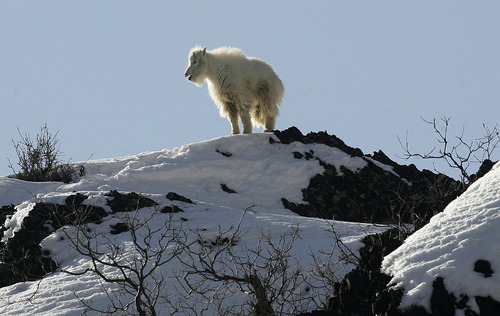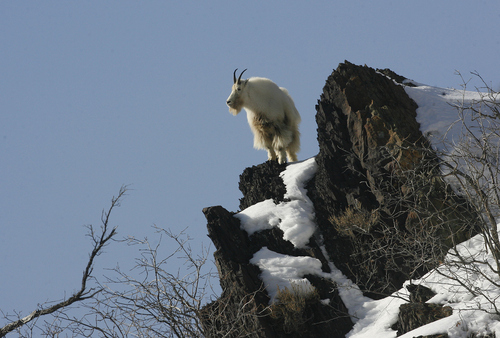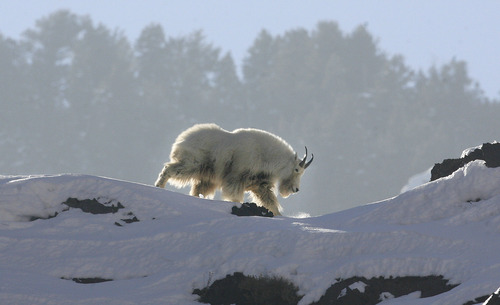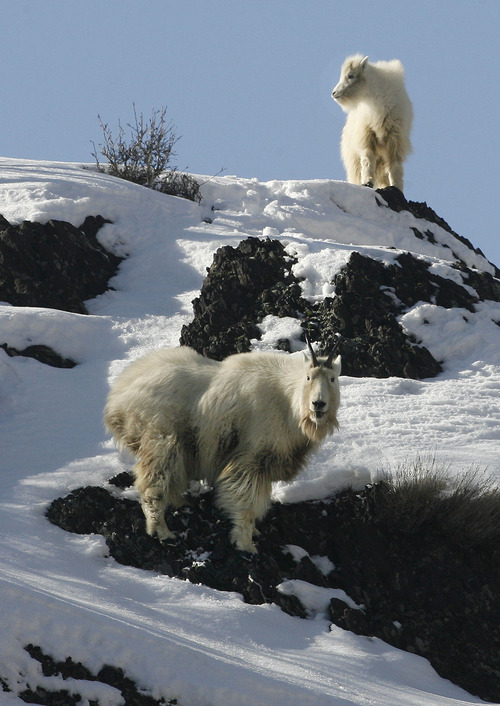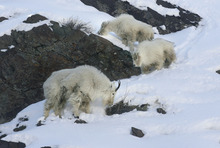This is an archived article that was published on sltrib.com in 2013, and information in the article may be outdated. It is provided only for personal research purposes and may not be reprinted.
State wildlife officials propose introducing mountain goats into new Utah ranges, but some conservationists are concerned this would put a non-native ungulate where it does not belong at the expense of sensitive alpine environments.
A draft plan to be considered by the Wildlife Board Tuesday calls for establishing "optimum populations of mountain goats in all suitable habitat within the state," which includes the La Sals and Deep Creeks.
Critics liken the proposal to "game farming," but DWR contends goats appear to belong in Utah mountains given the success in establishing populations.
"Mountain goats are a valuable addition to our wildlife resource diversity and are a legitimate part of our modern Utah faunal landscape," the draft plan states.
That's nonsense, responds Dick Carter, founder of the now-disbanded High Uintas Preservation Council. There is no evidence that the modern mountain goat ever roamed the Rockies south of Idaho, he argued.
"If you are a science-based organization you are not going to transplant non-native invasive species into environments that they don't belong," Carter said. "We aren't doing this for ecological purposes. We are putting them out there to be raised and to be killed by hunters."
Officials hope to relocate about 40 goats into the La Sals, the mountain range rising to the east of Moab, as early as this fall, but they will likely wait in light of local opposition.
"We have done modeling and based on goat densities in other areas, we project without any damage we can handle a couple hundred goats on that mountain," said Kent Hersey, DWR's big game project leader. This translates to between five and six goats per square mile above 10,000 feet.
Yet after 46 years of managing goats in Utah, DWR has yet to conduct a comprehensive study of how introduced populations affect high reaches of the Wasatch, Uinta and Tushar ranges, critics argue.
Moab-based conservationist Wayne Hoskisson, who serves on DWR's southeast resource advisory council (RAC), is concerned the agency has examined the ability of the La Sals to support goats without considering these animals' impact on a delicate landscape.
"It's a small range," Hoskisson said. "The amount of territory the goats would survive on would be small and there would be competition from other ungulates, both domestic and wild. Deer, elk and cattle inhabit the mountains in summer."
Adding another browse species could make matters worse for willow and aspen, two crucial alpine plants that are in trouble in the La Sals, Hoskisson said. At a May 8 RAC meeting, he moved to have the La Sals removed from the proposed plan, but the motion was narrowly defeated.
In a May 3 letter, U.S. Forest Service officials endorsed the statewide plan, but insisted on federal participation in plans for individual units, like the one that would be developed for the La Sals.
The service wants to keep tabs on goats' impact on sensitive plants endemic to this range and on the Mount Peale Research Natural Area surrounding the La Sals' highest peak at 12,721 feet, according to Mike Diem, the Moab district ranger for the Manti-La Sal National Forest.
According to Hersey, DWR has monitored endemic plants in the Uintas and Tushars and found goats had little impact on them.
The proposed statewide plan envisions "augmenting" existing goat populations through transplants on Loafer Mountain, Box Elder Peak, Mount Nebo, Lone Peak, the High Uintas, Ogden Peak, the Wellsvilles and Mount Dutton. Many of the animals would be transferred from thriving populations on Willard Peak and in the Tushars, according to Hersey.
Mountain goats in Utah
This wild ungulate is native to the Northern Rockies and Cascades, and was artificially introduced to Utah in 1967 when the state put some in Little Cottonwood Canyon. Mountain goats now occupy upper elevations through parts of the Wasatch, Uinta, Wellsville and Tushar ranges. The Utah Wildlife Board on Tuesday will consider a five-year mountain goat management plan that would introduce the goats in much smaller mountain ranges, raising concerns that state officials are putting delicate alpine landscapes at risk for the sake of expanding hunting opportunities. The state's goat population now exceeds 2,000 and DWR issued a record 175 hunting permits last year.



